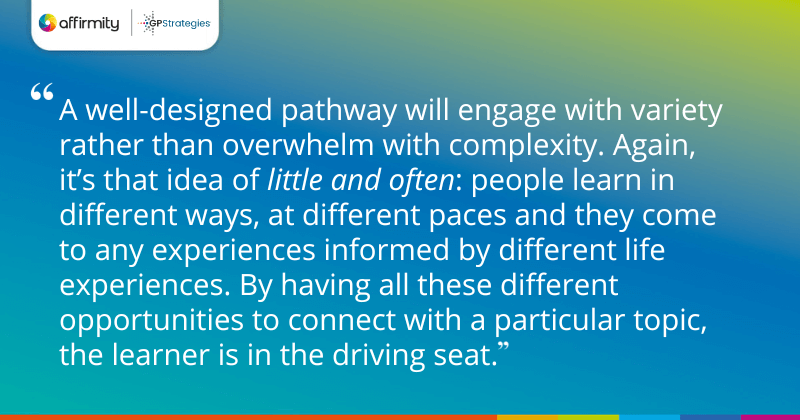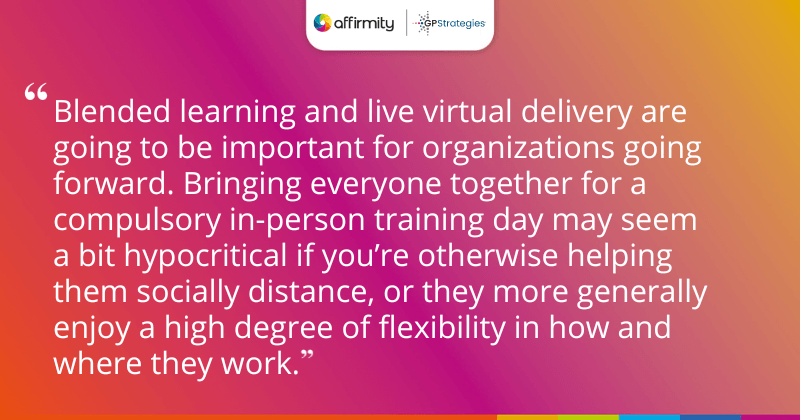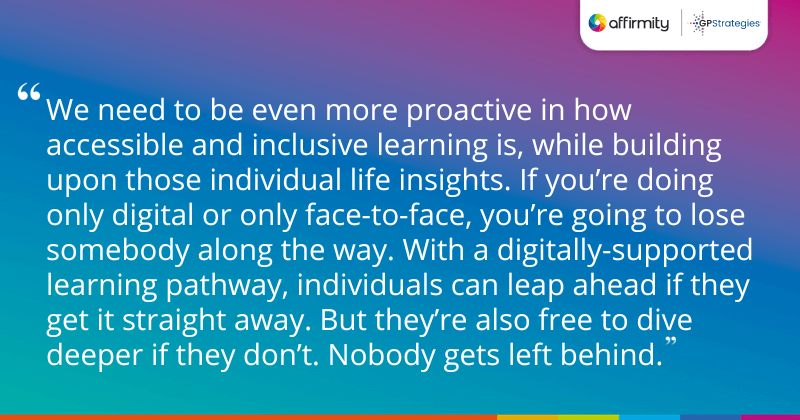There remain few constants that the modern employee can depend on in an uncertain working world. Well-meaning but questionably effective diversity training is surely among them. Thankfully, it doesn’t have to be that way! In this Q&A with Nic Girvan, Learning Director, and Angela Peacock, Director of Global Diversity and Inclusion at GP Strategies, we explore how a blended learning approach promises to help these crucial D&I training messages stay and better resonate with your employees.
Q: Starting With the Basics, What Is Blended Learning?
Nic Girvan: Blended learning combines the benefits of instructor-led experiences—either face-to-face or live virtual—with digital learning methodology. This could be eLearning, microlearning, digital toolkits, anything that doesn’t require an instructor. Outside of these formats, the key thing to know is that it’s a “little and often” approach. Rather than doing everything in one go, there will be multiple stop-points.

Angie Peacock: It’s also about appealing to different types of learners. If you look at, for example, PDT’s Accelerate programs, there’s a mixture of virtual face-to-face, one-on-one coaching, discussions, and digital resources such as videos and podcasts. In that sense, we’re blending a wide range of media and delivery types for learning purposes.
The old days of blended learning used to be a far more limited combination of face-to-face sessions and post-teaching workbooks. Now, it can be so much more: you could be doing an intensive training workshop with a small group, then be asked to join an all-company conference, then be asked to coach, complete some eLearning, microlearning, and view nudge material along the way.
NG: A well-designed pathway will engage with variety rather than overwhelm with complexity. Again, it’s that idea of “little and often”: people learn in different ways, at different paces and they come to any experiences informed by different life experiences. By having all these different opportunities to connect with a particular topic, the learner is in the driving seat and free to find the bits that they’re really going to engage with.
FURTHER INSIGHTS FOR VIRTUAL WORKING | ‘5 Virtual ERG Lessons Learned From Lockdown’
Q: What Are the Key Benefits of Blended Learning for Employers?
NG: The obvious benefit of blended learning for employers is the cost savings. Instructors (rightly!) don’t work for free, so an instructor-led pathway will have that ongoing cost associated with them. There are also the productivity costs involved in block-booking everyone’s time so that they can attend sessions.
Another important benefit is accessibility. You still have those set moments when your learners will go to an instructor event or group discussion, but they’ve also got these resources that they can access at any time or when information needs reinforcing.
Then there’s the effectiveness of blended learning. Moving away from the block-delivery of the learning means that it will embed more quickly and, therefore, will be easier to recall. We’ve all been on two-day courses and ended up with acute amnesia for whatever happened on the morning of day one—no matter how engaging the speakers were. Blended learning programs involve plenty of brief but highly-effective touchpoints in the weeks and months ahead, that protect employer investment in the training they deliver.
Q: How Do Employees Benefit From Blended Learning?
NG: Our attention naturally ebbs and flows throughout our daily lives and blended learning is far better at accommodating that. Even something as simple as writing down a great point an instructor makes can put us out of sync with the rest of the room. If we can’t go and do a deeper dive with a micro-module, a reading recommendation, or by attending a conference, the content we miss remains missed. It’s all about putting yourself in control of your learning.
AP: Obviously, the way that blended learning sticks for much longer benefits the employee just as much as the employer. That blended learning better engages learners on an emotional level, as well as a practical one, should also be considered. Expanding the variety of available approaches ensures that learning will hit upon what motivates an individual while using collaborative and face-to-face modes that stimulate us socially.

NG: We connect better emotionally with topics when learning messages are repeated to us. Blended learning helps us focus on finding ways of repeating and reinforcing that message without wearing it out.
MORE FROM THE BLOG | ‘One Size Doesn’t Fit All: Why Inclusion Training Must Always Be Tailored to Your Audience’
Q: What Does Blended Learning Look Like in PDT’s Current Course Repertoire?
NG: We’ve been working with blended learning for some time now. When we’re creating our digital catalog, it feeds into our existing live virtual one. It’s not anything new or anything different for us—it’s just how we do it!
In 2020, we were reinforcing our allyship resources in response to the growing number of questions coming from corporate leaders during the Black Lives Matter protests. We created a blended pathway for allyship that starts with a learning module to prime the learner on what they need to know and why it’s important. Learners then attend a live virtual session with a subject matter expert, and that’s where they socialize the learning: they learn from peers and the trainer’s expertise. Finally, they received the allyship nudges—three video prompts and a quick reference guide that remind them of everything they’ve learned to date.
AP: It’s a great position to be in, considering that the working world is itself in the process of reshaping into a “blended”, hybrid way of working. Blended learning and live virtual delivery are going to be important for organizations going forward. Bringing everyone together for a compulsory in-person training day may seem a bit hypocritical if you’re otherwise helping them socially distance, or they more generally enjoy a high degree of flexibility in how and where they work. If blended learning wasn’t also giving you more bang for your buck, you’d have more of a dilemma.
Q: Is it Possible to Get Blended Learning Wrong?
NG: One thing that derails some attempts at blended learning is when learning designers fail to acknowledge that learning no longer needs to be exclusively transferred from a trainer to an audience.
So you’ll see things like eLearning modules that simply duplicate the content of an upcoming live experience—as a learner, this is clearly a bad experience. You turn up, hear exactly the same points again, and feel like you’ve wasted your time. Good blended learning repeats points sparingly and for effect. It finds genuinely new ways of presenting key points and brings in other sources and perspectives to enhance what you’ve already learned.

You also have to look at the balance of what you’re providing. It’s not enough to tick the boxes for the sake of variety; you have to give each component appropriate room to breathe. Breakout groups are a good example of something that, while valuable, can crowd out other aspects of the event if left to overrun.
One great learning idea doing the rounds at the moment is that of the flipped classroom—learning should no longer be just about trainers as the font of all knowledge, ‘downloading’ information to learners. In the flipped classroom, participants come with knowledge, trainers add personalized insight, and blended learning is fantastic at creating the venues for that.
Still, in situations such as breakout groups, you can only deliver on that promise if trainers have the expertise and the space to ignite discussion on the most interesting points that each group raises. You need to facilitate more than just the beginning and end of each session: encourage everyone to get involved, but elevate and add expert insight those contributions that are most relevant and interesting.
STAY ON THE RIGHT PATH | ‘8 of the Most Common Challenges for Diversity Equity & Inclusion Today’
Q: Can Blended Learning Help Organizations Make Learning More Inclusive?
NG: Definitely, yes! For too long, we’ve steamrolled over the fact that people learn in different ways without taking into account those different learning preferences, paces, people’s backgrounds, and experiences. Right now, we need to be even more proactive in how accessible and inclusive learning is, while building upon those individual life insights.
If you’re doing only digital or only face-to-face, you’re going to lose somebody along the way. With a digitally-supported learning pathway, individuals can leap ahead if they get it straight away. But they’re also free to dive deeper if they don’t. Nobody gets left behind.
